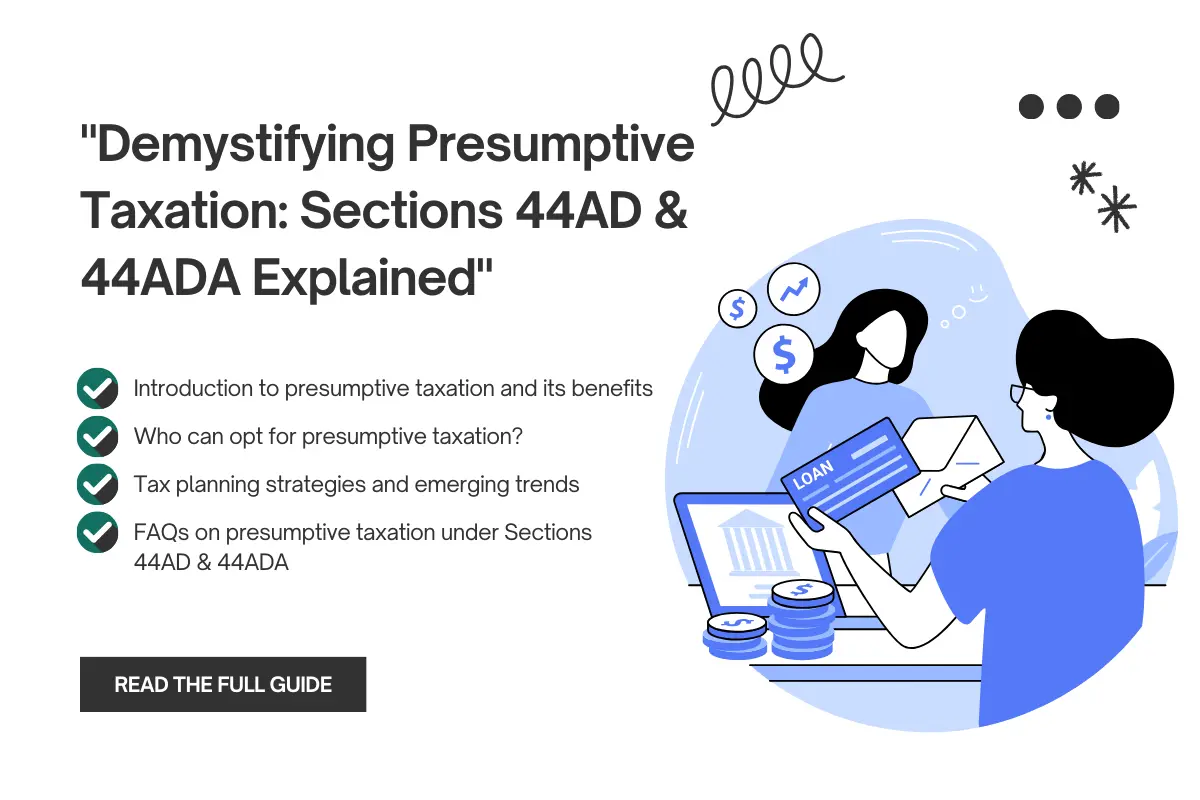
Sections 44AD & 44ADA in India (2024 Update)
No. | Section | Description |
|---|---|---|
1 | Introduction presumptive taxation 44ad income tax | Overview of presumptive taxation and its benefits |
2 | Understanding Presumptive Taxation | Definition and key sections (44AD & 44ADA) |
3 | Benefits of Presumptive Taxation | Reduced compliance burden, simplified filing, lower costs |
4 | Who Can Opt for Presumptive Taxation? | Eligibility criteria for businesses (44AD) and professionals (44ADA) |
5 | Important Considerations | Lock-in period, no expense deductions, advance tax |
6 | Steps to File a Tax Return under Presumptive Taxation (2024) | Gathering documents, choosing form, calculating income, filing electronically |
7 | Additional Tips | Consulting a tax professional, staying updated, maintaining records |
8 | Beyond the Basics: Advanced Considerations for Presumptive Taxation | Maintaining records even without mandatory accounting |
9 | Impact on GST Filing | Presumptive taxation doesn’t exempt GST filing if applicable |
10 | Special Cases | Perishable goods businesses & professionals with high expenses might not benefit |
11 | Tax Planning Strategies | Presumptive taxation as a starting point, explore regular filing later |
12 | Emerging Trends and the Future of Presumptive Taxation | Focus on digitalization and potential revisions |
13 | Frequently Asked Questions (FAQs) on Presumptive Taxation under Sections 44AD & 44ADA | Answers to common questions about switching, exceeding limits, deductions, etc. |
14 | Additional Resources | Links to Income Tax Department and CBDT websites |
1. Introduction
For many small businesses and professionals in India, navigating the intricacies of tax filing can be a daunting task. Thankfully, the Income Tax Act offers a simplified approach through presumptive taxation under Sections 44AD and 44ADA. This blog dives deep into these sections, explaining who qualifies, how it works, presumptive taxation 44ad income tax and the steps involved in filing a tax return under presumptive taxation.

2. Understanding Presumptive Taxation
Presumptive taxation allows eligible taxpayers to estimate their business income based on a pre-determined percentage of their total turnover or gross receipts. This eliminates the need for maintaining detailed books of accounts, simplifying the tax filing process.
3. Benefits of Presumptive Taxation
- 3.1 Reduced Compliance Burden: No need to maintain complex accounting records.
- 3.2 Simplified Tax Filing: Faster and easier return submissions.
- 3.3 Lower Costs: Saves time and money on accounting and tax preparation.
4. Who Can Opt for Presumptive Taxation?
Section 44AD (Businesses)
- 4.1 Businesses with a total turnover or gross receipts not exceeding ₹2 crore in the previous financial year (increased from ₹1 crore in Budget 2023).
- 4.2 Cash receipts must be less than 5% of the total turnover, otherwise regular tax provisions apply. This limit increases to 7.5% if the taxpayer has opted for online payment methods. (Note: Budget 2023 revisions are effective from Assessment Year 2024-25)
- 4.3 The business should not be engaged in specific activities excluded by the Income Tax Act, such as life insurance agencies, commission-based businesses, or plying goods carriages.
5. Section 44ADA (Professionals)
- 5.1 Individuals or partnership firms (excluding LLPs) carrying on specified professions.
- 5.2 Gross receipts from the profession must not exceed ₹75 lakhs in the previous financial year (increased from ₹50 lakhs in Budget 2023).
- 5.3 Cash receipts must be less than 5% of the total gross receipts, with the same online payment exception as Section 44AD.
- 5.4 Specified professions include doctors, lawyers, engineers, architects, consultants, and interior decorators.

6. Important Considerations
- 6.1 Once opting for presumptive taxation, a taxpayer must stay under the prescribed turnover or gross receipt limits for the next five years to remain eligible.
- 6.2 Presumptive taxation doesn’t allow claiming actual business expenses as deductions. The estimated income is considered the taxable income.
- 6.3 Advance tax must be paid on the estimated income calculated under presumptive taxation.
7. Steps to File a Tax Return under Presumptive Taxation (2024)
- 7.1 Gather Required Documents: PAN card, Aadhaar card (if applicable), bank statements, challan certificates for advance tax payments (if any).
- 7.2 Choose the Right Form: Individuals and partnership firms (excluding LLPs) use ITR-4 (Sugam).
- 7.3 Calculate Presumptive Income: For businesses under Section 44AD:
- If total turnover is less than ₹1 crore, presumed income is 8% of turnover.
- If total turnover is between ₹1 crore and ₹2 crore (and online payment methods are used), presumed income is 6% of turnover.
For professionals under Section 44ADA: Presumed income is 50% of gross receipts.
- 7.4 File Your Return Electronically: The Income Tax Department website (https://www.incometax.gov.in/iec/foportal/) offers online filing options.

8. Additional Tips
- 8.1 Consult a tax professional for guidance on eligibility and specific situations.
- 8.2 Stay updated on recent changes in the Income Tax Act, as budgetary revisions might affect presumptive taxation limits.
- 8.3 Maintain basic records of income and expenses for future reference and potential audits.
9. Advanced Considerations for Presumptive Taxation
- 9.1 Maintaining Records: Even though detailed accounting records aren’t mandatory, it’s advisable to maintain basic records of your income and expenses.
- 9.2 Impact on GST Filing: Presumptive taxation under Sections 44AD and 44ADA doesn’t exempt you from filing Goods and Services Tax (GST) returns if your business falls under the GST registration threshold.
- 9.3 Special Cases: Businesses dealing with perishable goods or having significant inventory fluctuations might find presumptive taxation less suitable, as the presumed income might not accurately reflect their actual profit.
- 9.4 Tax Planning Strategies: Presumptive taxation can be a good starting point for new businesses or professionals. However, as your income grows, it might be beneficial to consider transitioning to regular tax filing. Consult a tax professional to determine the optimal approach for your specific circumstances.
10. Emerging Trends and the Future of Presumptive Taxation
- 10.1 The government is actively promoting digitalization in tax processes. Expect increased focus on online transactions and record-keeping for presumptive taxation in the future.
- 10.2 Potential revisions to presumptive taxation limits or eligibility criteria might occur based on economic factors and tax policy changes. Staying updated through official channels is crucial.
11. Frequently Asked Questions (FAQs) on Presumptive Taxation under Sections 44AD & 44ADA
This section addresses some commonly asked questions regarding presumptive taxation:
- 11.1 : Can I switch between presumptive taxation and regular tax filing in the same financial year?
A: No, you cannot switch between these methods within the same financial year. Once you opt for presumptive taxation, you must remain under the scheme for the next five years. - 11.2 : What happens if my turnover or gross receipts exceed the prescribed limits in a particular year?
A: If your turnover or gross receipts exceed the limits in a year, you’ll be liable to file your return under regular tax presumptive taxation 44ad income tax provisions for that specific year and subsequent years. However, you can re-opt for presumptive taxation in the future if your income falls back within the prescribed limits. - 11.3 : Can I claim any deductions for expenses under presumptive taxation?
A: No, you cannot claim deductions for any business expenses under presumptive taxation. The presumed income is considered your taxable income. - 11.4 : How is advance tax calculated under presumptive taxation?
A: The advance tax liability is calculated based on the presumed income determined under Sections 44AD or 44ADA. You can use the Income Tax Department’s online portal for advance tax calculations. - 11.5 : What are the consequences of not filing tax returns under presumptive taxation?
A: Failing to file your tax return can attract penalties and interest charges on the tax payable. Additionally, it can lead to delays in processing any tax refunds you might be eligible for. - 11.6 : Can a company (limited liability company) opt for presumptive taxation?
A: No, companies (LLCs) are not eligible for presumptive taxation under Sections 44AD and 44ADA. These sections are applicable only to individual proprietors, Hindu Undivided Families (HUFs), and partnership firms (excluding LLPs). - 11.7 : Are there any specific software programs designed for presumptive taxation?
A: Several accounting software programs offer features specifically designed for presumptive taxation. These programs presumptive taxation 44ad income tax can help you calculate presumed income, generate challans for advance tax payments, and maintain basic records for your business or profession.
Remember: This blog provides general information and shouldn’t be considered a substitute for professional tax advice. Consult a qualified tax professional for personalized guidance on your specific situation.
12. Additional Resources
- 12.1 Income Tax Department website: https://www.incometax.gov.in/iec/foportal/
- 12.2 Central Board of Direct Taxes (CBDT) website: https://incometaxindia.gov.in/Pages/sitemap.aspx
By incorporating this FAQ section, the blog offers a more comprehensive resource for individuals and businesses seeking to understand the intricacies of presumptive taxation under Sections 44AD and 44ADA in India.
